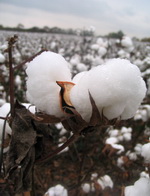
A Black (White) Hole in the Global Spread of GM Cotton
March 30, 2016| |
 Genetically modified (GM) cotton is the third largest biotech crop, occupying around 70 percent of the global cotton area, mostly involving insect-resistant Bt varieties. Bt cotton is particularly popular in developing countries such as China, India, Pakistan, South Africa, Burkina Faso, and others. In these countries, Bt cotton is grown by over 15 million smallholder farmers, contributing to significant economic, social, and environmental benefits. However, several low-income and important cotton producers do not use Bt technology. None of the Central Asian cotton producers – such as Uzbekistan, Turkmenistan, Tajikistan, Kazakhstan, and Kyrgyzstan – have yet adopted Bt cotton.
Genetically modified (GM) cotton is the third largest biotech crop, occupying around 70 percent of the global cotton area, mostly involving insect-resistant Bt varieties. Bt cotton is particularly popular in developing countries such as China, India, Pakistan, South Africa, Burkina Faso, and others. In these countries, Bt cotton is grown by over 15 million smallholder farmers, contributing to significant economic, social, and environmental benefits. However, several low-income and important cotton producers do not use Bt technology. None of the Central Asian cotton producers – such as Uzbekistan, Turkmenistan, Tajikistan, Kazakhstan, and Kyrgyzstan – have yet adopted Bt cotton.
In a recent study, Saule Burikbayeva and Jo Swinnen from KU Leuven and Matin Qaim from the University of Goettingen have analyzed possible reasons, including low acceptance levels, regulatory issues, or trade-related constraints. Yet, none of these typical political-economy arguments was found convincing. Instead, the most likely explanation is limited demand for Bt in Central Asia owing to low insect-pest infestation. This would imply that global Bt cotton adoption rates may already be close to 100% when considering real demand for insect-resistant varieties. The study was published in the April issue of Trends in Biotechnology.
The free link to the article, valid until 12 May is available at the Science Direct website.
| |
Biotech Updates is a weekly newsletter of ISAAA, a not-for-profit organization. It is distributed for free to over 22,000 subscribers worldwide to inform them about the key developments in biosciences, especially in biotechnology. Your support will help us in our mission to feed the world with knowledge. You can help by donating as little as $10.
-
See more articles:
-
News from Around the World
- New Approaches Needed to Meet Sustainable Development Challenges
- Nigeria's Science and Technology Minister Urges Use of Agricultural Biotechnology for Economic Development
- Researcher Improves Crop Performance through Biotechnology
- Gene that Blocks Lettuce Germination Also Regulates Flowering Time
- Four InnateTM Potato Events Granted Nonregulated Status in Canada
- USDA Deregulates Two Lines of GE Corn
- USAID Supports Cornell's Feed the Future South Asia Eggplant Improvement Partnership
- A Black (White) Hole in the Global Spread of GM Cotton
-
Research Highlights
- Isolation of Anthocyanin Pathway Regulator from Horny Goat Weed
- Advanced Flowering of Juvenile Citrus Induced by a Viral Vector
- The Role of Annexin Genes in Strawberry Fruit Development
-
Beyond Crop Biotech
- Discovery Shows Parallels Between Plant and Human Immune Systems
- Synthetic Cell Dies Without Mysterious Genes
- Study Reveals that Water Bears Do Not have Extensive Foreign DNA
-
Announcements
- 5th International Conference and Exhibition on Metabolomics
-
Read the latest: - Biotech Updates (December 10, 2025)
- Gene Editing Supplement (November 26, 2025)
- Gene Drive Supplement (February 22, 2023)
-
Subscribe to BU: - Share
- Tweet
